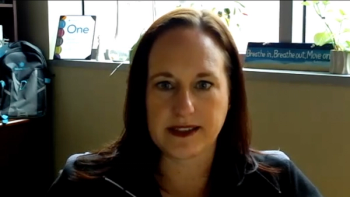
Oncology NEWS International
- Oncology NEWS International Vol 16 No 12
- Volume 16
- Issue 12
New oncology-specific EMR system available for testing
The high cost of implementing new technologies has slowed the adoption rate of health information technologies, especially among smaller oncology practices. Based in Rockville, Maryland, Argole Systems, Inc. is a software and services company that recently released the beta version of Akessa Oncology, its new oncology-specific practice management and EMR system. Cancer Care & Economics spoke with Argole president, CEO, and co-founder Masoud Khorsand, MD.
ABSTRACT: The high cost of implementing new technologies has slowed the adoption rate of health information technologies, especially among smaller oncology practices. Based in Rockville, Maryland, Argole Systems, Inc. is a software and services company that recently released the beta version of Akessa Oncology, its new oncology-specific practice management and EMR system. Cancer Care & Economics spoke with Argole president, CEO, and co-founder Masoud Khorsand, MD.
CC&E: Oncology practices worry about start-up costs and disruption associated with adopting electronic medical records (EMRs). How does your company address these concerns?
DR. KHORSAND: We currently offer an extended trial period, so practices can pace themselves in learning the various aspects of the system. Although we have not yet released the pricing for Akessa Oncology, it will certainly be structured to fit the budget constraints of a solo practitioner as well as those of large size practices.
Because it was designed from the ground-up, working closely in cancer centers with clinicians and billing and management staff, our system closely mimics the real-life workflows of an oncology practice.
So rather than forcing an oncology practice to adapt to atypical, nononcology workflows, Akessa Oncology minimizes disruption by providing a practice with the ability to automate their existing business and clinical workflows, thereby cutting back on training time and costs, and speeding up the implementation phase.
Furthermore, during implementation, we leverage our open architecture to import data from existing systems to make the transition as seamless as possible.
CC&E: What feature of Akessa Oncology would you tout as something that sets your product apart from other systems?
DR. KHORSAND: We have an integrated system that introduces efficiencies by having oncology-specific billing, patient scheduling, EMR, and pharmaceutical inventory management modules all communicate with each other to deliver an optimal clinical and business management solution for oncology practices.
Oncology offices today have one of the highest numbers of full-time staff per physician for a specialty practice, making staff productivity crucial to the financial viability of the practice. Creating a patch-work of different stove-piped solutions lowers productivity and increases the chance for human error.
As a typical example, ordering drugs, dispensing them for care delivery, and billing for them is usually done using separate inventory management, EMR, and practice management systems. Some of this, especially inventory control, may even be done via paper, thereby pushing the burden of accuracy to an already overworked billing or nursing staff.
Errors and omissions are hard to control in such a situation and remain largely uncovered, costing practices thousands of dollars every year in missed or incorrectly billed charges.
A lowest common denominator approach also carries with it hidden maintenance costs due to varying levels of compatibility between various vendors. Consequently, upgrades are slow and expensive, denying practices timely clinical and financial updates and preventing practices from benefiting from advances in technology. Even today, it is quite common to find practices using pre-Internet era software built with decades-old technology.
CC&E: Is there a particular size and model of oncology practice that your system best fits?
DR. KHORSAND: Our scalable and open architecture utilizes the latest in Internet technologies, ensuring that we can handle a large number of users, whereas our affordability makes it easier for smaller practices to acquire our solution. We cater to all practice sizes, from solo practitioner to high-volume practice.
CC&E: Does your medical billing component help capture charges that may otherwise get lost in the complex web of coding?
DR. KHORSAND: The unique complexity of oncology billing has traditionally been the domain of a seasoned and experienced oncology billing professional.
Although the need for qualified staff is crucial to the success of any enterprise, it is no longer possible to ensure an adequate and attrition-proof supply of oncology billing talent that can meet the growing financial and billing challenges practices face today.
Leveraging the expertise of professionals in our oncology billing division, which provides billing services (known as Revenuity) to cancer centers, Argole Systems evolved a sophisticated billing rules engine that powers the billing solution of Akessa Oncology. It ensures accuracy at the point of charge capture and takes out the complexity to the extent that even a billing professional with little training in oncology can accurately bill for the cancer care delivered.
Through its robust contract assurance and denials management capabilities, our billing solution makes it easier to ensure effective business oversight over day-to- day clinical operations.
CC&E: Does your system work well with others?
DR. KHORSAND: One of the major reasons for the slow pace of technology adoption in healthcare has been the lack of interoperability between the various IT vendors. Akessa has an open architecture that makes it quite easy for other vendors willing to integrate with our solution as well as enabling Akessa to interface with other technology partners.
Our system also supports HIPAA-compliant X12 EDI transactions for eligibility verification, electronic billing, and payment posting. Further, we support HL7 and ASTM CCR [continuity of care record] standards for seamless integration with other payers, clearing houses, laboratories, and HIT [health information technology] systems.
Articles in this issue
about 18 years ago
Third-line single-agent cetuximab ups overall survivalabout 18 years ago
Modern multislice CT propels pancreas imaging forwardabout 18 years ago
Sorafenib gets ok for liver cancerabout 18 years ago
Celgene to acquire Pharmionabout 18 years ago
Novacea halts ASCENT-2 trialabout 18 years ago
RT/temozolomide raises possibility of cure in glioblastomaabout 18 years ago
Brachytherapy as effective in younger as in older menabout 18 years ago
MMA not harming patientsabout 18 years ago
Kinase inhibitor may prevent RT-induced lung injuryabout 18 years ago
FDA approves lower starting dose for dasatinib for CMLNewsletter
Stay up to date on recent advances in the multidisciplinary approach to cancer.
















































































